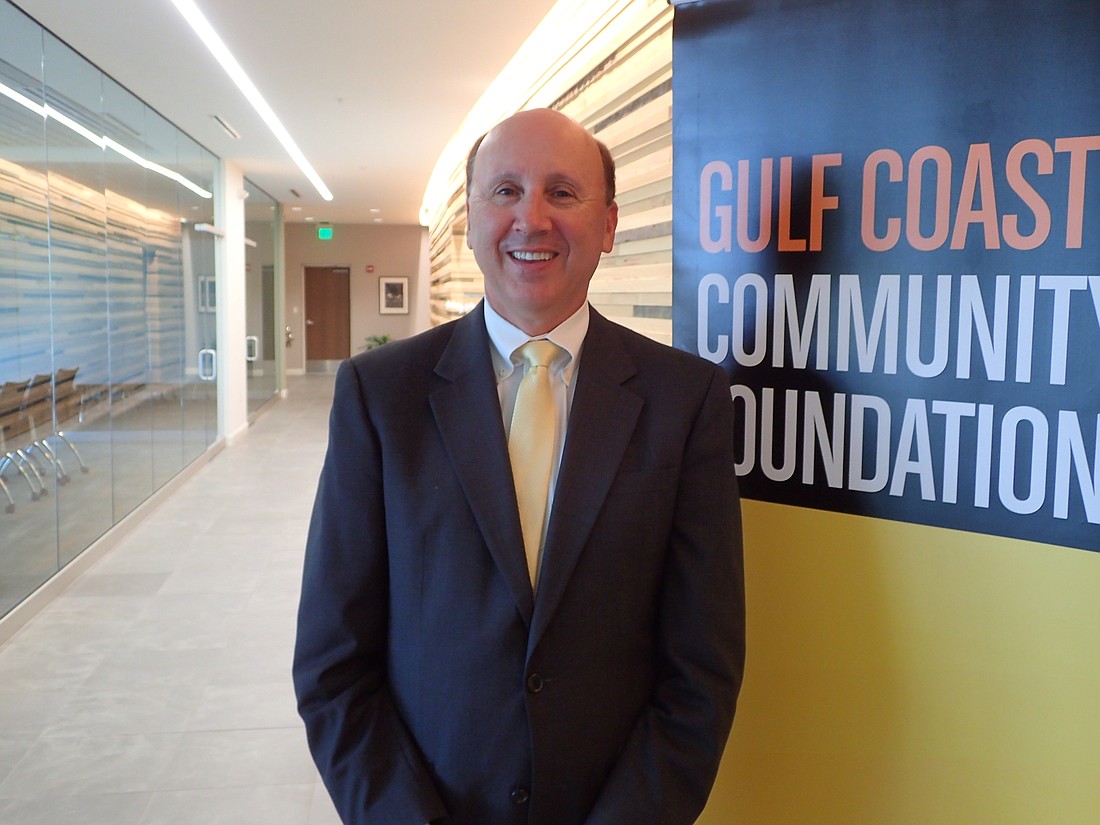- November 13, 2025
-
-
Loading

Loading

Gulf Coast Community Foundation President and CEO Mark Pritchett has a background in public policy research and higher education, but he considers himself an entrepreneur at heart.
Recently promoted to the role of president/CEO, Pritchett joined the foundation staff in 2008. He’s been involved in programs that combine education and the workforce, such as STEMsmart and CareerEdge. He also launched the Gulf Coast Innovation Challenge, to spur sustainable economic development in the marine sciences sector.
What are some of the challenges nonprofits face today?
Now that we’re coming out of the recession, they have more money, which is good, but there’s such a proliferation of nonprofits in our region that makes it difficult sometimes to schedule things and get things done and get all the right donors in, in a big way.
This year, we had some nonprofits like Boys and Girls Club and Big Brothers, Big Sisters take a hit because Gov. (Rick) Scott vetoed some dollars, and they were safety net dollars ... So we’ve been having to help some nonprofits with that.
As the recession abated, did GCCF change its focus?
Since 2010, we’ve been doing less responsive grant-making and more large initiatives where we focus on data and information.
We look at a system, and then, we attack the system and bring our nonprofits in to help us, and then we fund them, instead of the nonprofits coming at us and saying, “This is what I think the problem is.” The challenge with that is they come from a certain constituency, a certain perspective, but sometimes, they don’t see the big system.
For the Homeless Children and Families initiative, we’ve brought over 30 nonprofits together — and it was really interesting where they saw gaps in the system. We said, “How do we make this more of a seamless system to help our children and families?”...Having that more systemic approach is smart philanthropy.
How does GCCF deal with overlapping initiatives with local governments?
What we don’t want to do is fill the role that we think government should take, but we’re happy to take a problem or an issue and find a more efficient or effective way to deal with it and put our money, invest in it and show how it can work.
With CareerEdge, our workforce initiative, our CareerEdge point person, Mireya Eavey, actually sat with the school board and the county government and presented data saying, “Our local manufacturers aren’t getting the skilled workforce they need, and here’s where we can start.” Mireya took 60-plus job descriptions and distilled them down into a core set of skills.
With that information, we came up with a precision machining program in about a six- to nine-month time period.
Describe the foundation’s relationship with universities locally and statewide.
Every year, we provide scholarships to qualified students who can go to either local or out-of state-universities. ...
With State College of Florida, we put in some significant seed money back in 2009 or 2010 to get its four-year nursing degree going. ...
The third thing that we’ve been involved in just recently is called C4, the Creative Coast College Consortium. We’ve been meeting with the university presidents locally ... and they want to meet on a regular basis. They want to start sharing courses and classes and maybe some different operations like emergency management together.
What are the long-term plans for maintaining and expanding your donor base?
A community foundation has to meet the public support test, meaning, if we’re to continue to get IRS tax-exempt status, we’re to bring in new donors constantly. We just can’t have one single big lump of money and not get donors. So my predecessor, Teri Hansen, did a great job of that.
What we want to do is continue that trajectory. Since 2008, we’ve had this exponential rise in the number of new donor funds. We went from less than 100 to over 600 funds. We have a certain kind of donor profile that we look for — people who are interested in our initiatives, people who want systemic change, people who like big ideas, big impact.
Tell me about your long-term goals for the foundation.
We have to cultivate philanthropy in the next generation, and it looks really different.
(The next generation goes) after causes more than they do organizations. They use technology more. They are even forming for-profit corporations that split off part of their profits to do good, like Tom’s shoes, Ben & Jerry’s, and so they attract a whole different market, and we have to adjust to that.
What are your personal goals for the foundation?
I’ve told my board I want them to feel engaged and feel like we’re a leader in the community, and I want our staff to perform at a high level of excellence.
Our value proposition is not about not how big our endowment is, and it’s not how many donors we have. All that is important, but it’s how we’re perceived as leaders in the community that matters most. That’s where we make our change and attract donors.
What can we do to enhance entrepreneurialism in our community?
I think the Bayfront 20:20 is a wonderful opportunity. We’re sort of working behind the scenes to make sure people are working together to make the best use of that. I think that’s a critical economic development.
— Jack Short